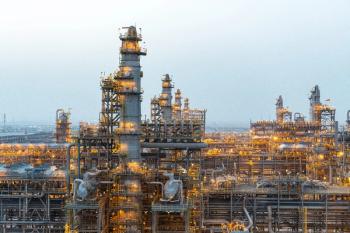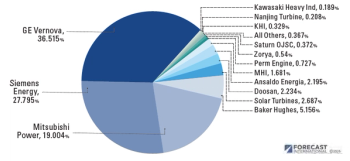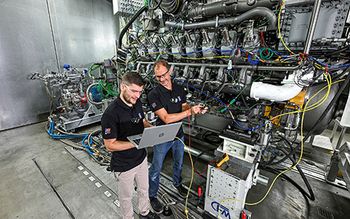
ATPS INDUSTRY SUMMIT
BIG DATA, DIGITALIZATION AND THE INDUSTRIAL
INTERNET OF THINGS
BY KALYAN KALYANARAMAN
The biennial Asia Turbomachinery & Pump Symposium (ATPS) grew out of Texas A&M Turbomachinery Laboratories’ (TAMU) annual Turbomachinery & Pump Symposia (TPS). This year’s Industry Summit was conducted in Kuala Lumpur, Malaysia.
The welcome address by Dennis Lawrence, Head of Wells at Petronas, touched upon the development of young engineers and machine learning applications for asset management. Further speakers emphasized trends, such as big data, digitalization and the Industrial Internet of Things IIoT). Viewpoints ranged from skepticism through grudging acceptance to wholehearted endorsement of these mega trends. Eight case studies covered a cross-section of rotating machinery problems.
“More and more, the participants want to return to their workplace and apply what they learn,” said Eric Petersen, Director of Turbomachinery Laboratories. “That’s why content is weighted in favor of case studies.”
Petersen sees supercritical CO2, high pressures in compression, advanced materials to handle corrosive gas use, combustion at different operating conditions, and bearings as the areas where cutting-edge research and technology development is happening. He raised concern about the knowledge gap created because of the retirement of a generation of turbomachinery engineers.
ATPS chair Dag Calafell said current buzzwords, such as big data and predictive analytics are often driven by this knowledge gap. “Asset management that improves safety and operability while reducing cost is a big trend,” he said. “Due to attrition in expertise, assets are vulnerable to declining reliability, especially in offshore production.”
He called for greater collaboration to break down the barriers imposed by proprietary development. Otherwise machinery domain knowledge may not be available to end users.
Future technology
Junya Ujiie, Senior Vice President of Asia Pacific at Mitsubishi Heavy Industries, said his company is focused on technologies to sharply lower carbon emissions. Products for the future will be high-efficiency, large-capacity gas turbine (GT) combined cycles, GTs burning hydrogen, integrated gasification combined cycle, solid oxide fuel cells and machinery for nuclear power. Its next generation combined cycle will have a projected efficiency of 65%. With integrated SOFCs, this could reach beyond 70%.
In post-combustion CO2 capture, Mitsubishi delivered the Petra Nova plant in Texas that started operations in 2016. Five thousand tons of CO2 are captured every day and used for enhanced oil recovery. The Mitsubishi equipment includes an eight-stage integrally geared compressor and a CO2 inline compressor with a discharge pressure over 200 bars (2,900 psig).
To cater to remote, off-grid areas near coasts, Mitsubishi developed a floating LNG power plant with an integrated supply chain. It leverages MHI’s capabilities in LNG shipbuilding and power plants. The DNV-approved solution is economical if fuel costs do not exceed $10 Mbtu.
Mitsubishi offers several power ranges. For large outputs of 150 to 350 MW, the lead time is under three years. The combined cycle plant onboard would have efficiencies in the range of 50% to 56%. For up to 100 MW, the prime mover can be either gas turbines or gas engines, with delivery in one year. Efficiency would range from 35% to 50%. The supply chain would include small LNG shuttles to transport fuel from bigger vessels.
Digital twin
A lecture by representatives of Tri-Sen and Elliott Group outlined the compressor digital twin. Klaus Brun, Elliott’s R&D director, said trends like Artificial Intelligence (AI), digital twin and IIoT have two drivers. One is a generational change among those working in the industry. They are accustomed to computers and prefer simulations.
The second reason: veteran turbomachinery experts who can predict machinery condition are retiring. AI is required to help replace their expertise.
Jim Jacoby, VP of engineering at Tri-Sen, explained the nuances of the digital twin. A physics-based simulation of the machine generated by OEM-supplied parameters is compared with the actual equipment.
The digital twin allows the operator to compare predicted results with real-world performance to identify emerging malfunctions or opportunities. Jacoby explained that head, flow, speed, as well as gas molecular weight and conditions such as pressure and temperatures are required inputs for the model.
The digital twin lecture prompted lively discussion. A key point emerged: compressor surge lines may have altered in the field because of changed impedances due to piping. Brun explained that so much effort goes into simulation and modeling, yet instrument errors can introduce errors in predictions.
Dr. Masdi bin Muhammad from UTP presented a keynote on predictive analytics. We need to use maintenance and operational insights, he said, and ensure operational efficiency through alarms prioritization and recommendations. But challenges such as unreliable data, selecting the right model, and frequent changes in the field must be overcome.
Industrial Revolution 4.0
On Day Two of the summit, Hj Khairol Anuar Shukri, Head of Group Technical Solutions, Project Delivery and Technology of Petronas, outlined the broad trend of what is known as the Industrial Revolution 4.0. The first industrial revolution involved steam power and mechanization. The second phase in the 1870s brought about mass production. The next revolution came about through computers and electronics starting in the late 60s.
The features of the present one, IR 4.0, are cyber physical systems, IIoT and networks, he said. The key enablers are AI, cloud, system integration, simulation, robots, big data and digitalization.
Market disruptors are operating in tandem to IR 4.0 are U.S. shale production, technological innovation, environment concerns and the public’s perception of the industry. During every industrial revolution to date, some large companies disappear without trace. To stay relevant, it is necessary to adapt, digitalize and collaborate.
This means working together with governing bodies, standards organizations, higher learning institutions and engineering fraternities where all participate, said Shukri.
For instance, even a few years ago, the big oil and gas companies had difficulty achieving standardization of commonly used equipment.
Today, the Christmas tree, switch gear and other equipment are standardized. This reduces the need for specification overlays, reduces costs and cuts delays, said Shukri.
“Transparency and communication are the key to facilitate networking within organizations and without.”
The last session on IIoT was kicked off by Girish Kamal, Principal Rotating Engineer from Petronas Upstream. He talked about the need to become a data-driven organization and how the world’s top performing companies harness data for insights to make smarter and faster decisions and unlock new value.
Dr. Ir. Harris A. Rahman Sabri, Staff Rotating Engineer from Pet ronas Upstream showcased his company’s journey in developing Petronas Rotating Equipment Analytics (Protean), an in-house predictive maintenance solution that covers 79 GTs, 35 pumps, 50 compressors and 29 generators. Some decisions are referred to humans while others are made by computers.
Arun Kumar, General Manager for Reliability and Maintenance at HPC, Mittal Energy of India, gave a presentation about his company’s digitalization plans and how AI had reduced downtime. Polypropylene, for example, could sometimes solidify in the reactor during process upsets and lead to weeks of shutdowns. AI prevents solidification via a closed-loop feedback system.
Sandip Jadhav, CEO of CCTech, a software solutions firm based in Pune, India, used big data to design butterfly valves to maximize the fl ow coefficient and minimize the hydrodynamic coefficient.
A lively interaction followed among the panelists. Rainer Kurz, Manager of Systems Analysis at Solar Turbines, asked how to choose between physics-based models and big data. Jadhav responded that in the butterfly valve case, the traditional approach would be to use CFD and attempt a solution to the Navier Stokes equation. This would require a trade-off between speed and accuracy.
"The effectiveness of machine learning models depends on the data,” said Jadhav. “We used a combination of physics and machine learning to reduce cycle time. Physics-based models are not adaptive.”
A four-day ATPS Symposium and Exhibition is scheduled for April 7–11, 2020 at the Kuala Lumpur Conference Center.
Newsletter
Power your knowledge with the latest in turbine technology, engineering advances, and energy solutions—subscribe to Turbomachinery International today.





